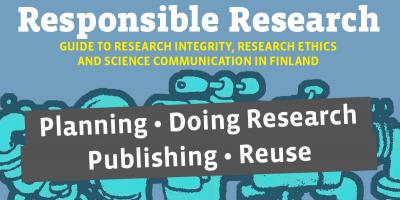For scientists, social media opens up a new way to participate in global and national discussions and to share information.
What if you could attend a scientific conference from a plane, from a formal dinner or while sitting at home watching television on the sofa? In April 2017, a group of neuroscientists spent ten hours sitting in the premises of Aalto University monitoring the #brainTC hashtag on Twitter. The event was a scientific brain research conference and it was completely virtual. People attended it from wherever they happened to be. All the talks and discussions took place under the Brain Twitter Conference hashtag, #brainTC. According to the organisers, the virtual conference reached up to half a million people on social media across the globe.
The work of experts is going digital at a rapid pace. Sharing information, meetings and discussions between and within different fields are increasingly being conducted on various social media channels. To scientists, social media offers a major opportunity because it enables participation in global and national discussions and information sharing both within one’s own field and outside it in a whole new way. With a few clicks, you can get your message to the Prime Minister of Finland or a research colleague in Australia.
There are a huge number of social media channels, so keeping track of all of them would naturally be impossible. Social media can absorb endless amounts of time. This means it makes sense to take a strategic approach to your own channels and the way you use them.
Twitter is a good channel for researchers because it now reaches a large number of people across the globe – scientists and decision-makers, journalists, civil servants and other people with influence in society.
Here are ten tips you could start applying to your own Twitter use. Twitter is a good channel for researchers because it now reaches a large number of people across the globe – scientists and decision-makers, journalists, civil servants and other people with influence in society. You can network within academia and outside it in the same channel.
1. Log into Twitter as an individual, not as a project
Researchers should log into Twitter as private individuals because opinions presented under your own identity are much more interesting than content produced under the name of a generic-sounding research project. Research projects are usually short and time-limited. Growing an audience is hard work so instead of creating an account for the research project, it is more efficient to choose a good hashtag for the project and use that while communicating via your own personal account.
2. Consider what you want to achieve
Strategic use of Twitter means thinking about who you want to reach on social media, what you want to communicate to them when spending time on the service and what kind of usage habits will attain your goal, for example, what kinds of tweets it is worth writing at what times of the week. You can set goals, for example, to extend your own professional network, for a research project in progress, for an individual conference or even for employment after completing your PhD.
3. Follow people whose attention you want to attract
Success in social media is based on interaction. If you want people to react to tweets and follow you, you often have to take the initiative. Follow the people who you would like to follow you. Make sure that your profile text is informative and that you have uploaded a profile picture of yourself.
4. Check out important hashtags in your field and use them
Topics you are interested in can handily be followed on Twitter using keywords, i.e. hashtags. These are words (without spaces) preceded by a hash sign, such as #bioeconomy, #climatechange or #safety. For research projects, it is a good idea to think about giving them their own hashtag. Check whether the tag you have chosen is already used on Twitter before you start using it. A good hashtag is short and informative.
5. Post content that is useful to your followers
Post material that is useful and interesting to your followers so that people become interested in your tweets. The information does not have to be produced by you; you can share links to articles and retweet other people’s stories. Twitter is above all a platform for sharing content.
6. Share things that are easy to react to
People like commenting, liking and sharing on social media so interaction with other users is created by sharing content that people find it easy to react to. You can always ask, for example, what your followers think of a particular issue or what should be done about it.
7. Use links and photos
Use as many photos and links as possible in your tweets. They have been shown to attract people’s attention and gain a reaction. Photos taken on your phone are perfectly fine.
8. Experts can tweet about leisure activities or politics too
On Twitter, a researcher may share and comment on tweets that are not closely linked to their own field of research and doing so is worthwhile. As a researcher, you can comment on the Eurovision Song Contest or the Ice Hockey World Championships in the evening and tweet about your scientific conference during the day.
9. Twitter is an endurance sport
To benefit from Twitter, you need to use it regularly and for a longer period of time. Followers often increase slowly. If you don’t publish anything, people won’t notice you. Twitter is worth incorporating into your daily routine, e.g. on the bus in the morning, in a lunch break or while waiting for a meeting to start. Regular ten-minute use every day produces better results than an hour once a fortnight.
10. Remember that everyone is practising and it is very difficult to mess up completely
You learn to use social media by using it. Your skills and your number of followers often grow at the same rate. It is very difficult to completely mess it up unless you write something criminal, sexist or racist. Social media services are developing so quickly all the time that it’s a full-time job even for a communications expert to keep up with all the twists and turns. So don’t worry about not performing your job as an expert well on social media because everyone, from professional users to beginners, is constantly practising.
The list in this piece is modified from a list presented in the book Tutkimuksesta toimintaan – tieteentekijän opas viestintään ja vaikuttamiseen (Art House, 2018.)
Maria Ruuska, Senior Communications Specialist and Co-founder, Kaskas Media
You might also be interested in
Tämä teos on lisensoitu Creative Commons Nimeä 4.0 Kansainvälinen -lisenssillä. Detta verk är licensierat under en Creative Commons Erkännande 4.0 Licens. This work is licensed under a Creative Commons Attribution 4.0 International license.

